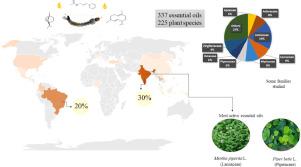Acta Tropica ( IF 2.7 ) Pub Date : 2020-09-19 , DOI: 10.1016/j.actatropica.2020.105705 Tássio Rômulo Silva Araújo Luz 1 , Ludmilla Santos Silva de Mesquita 1 , Flavia Maria Mendonça do Amaral 1 , Denise Fernandes Coutinho 1

|
This review focused on the toxicity of essential oils and their constituents against Aedes aegypti L. (Diptera, Culicidae) larvae, a key vector of important arboviral diseases, such as dengue, chikungunya, zika, and yellow fever. This review is based on original articles obtained by searching major databases in the last six years. Our literature review shows that 337 essential oils from 225 plant species have been tested for larvicidal bioactivity. More than 60% of these essential oils were considered active (LC50<100 µg/mL). Most species belong to the families Lamiaceae (19.3%), Lauraceae (9.9%), and Myrtaceae (9.4%). The plants studied for their larvicidal activity against A. aegypti were mainly collected in India and Brazil (30 and 20%, respectively) and the parts of the plants most used were the leaves. Less than 10% of essential oils were evaluated for toxicity against non-target organisms and with the aim to demonstrate safe use. The most used plant parts are leaves and the main compounds of essential oils were described. The most active essential oils are rich in sesquiterpene hydrocarbons, oxygenated sesquiterpenes, and monoterpene hydrocarbons. Here, factors affecting bioactivity (chemical composition, plant parts, and harvesting site) of essential oils and their constituents, as well as safety to non-target organisms are discussed. Essential oils have considerable potential against A. aegypti. This review shows that essential oils might be used to control arboviruses, and further studies on safety and formulations for application in the field should be performed.
中文翻译:

精油及其抗埃及伊蚊幼虫的化学成分。
这篇综述集中于精油及其成分对埃及伊蚊幼虫的毒性,伊蚊幼虫是重要的虫媒病毒疾病的重要媒介,例如登革热,基孔肯雅热,寨卡病毒和黄热病。这篇评论是基于过去六年中通过搜索主要数据库而获得的原始文章。我们的文献综述表明,已经对来自225种植物的337种精油的杀幼虫生物活性进行了测试。这些精油中超过60%被认为具有活性(LC 50 <100 µg / mL)。大多数物种属于唇形科(19.3%),月桂科(9.9%)和桃金娘科(9.4%)。研究了这些植物对埃及伊蚊的杀幼虫活性主要收集在印度和巴西(分别占30%和20%),最常用的植物部分是叶子。评估不到10%的精油对非目标生物的毒性,目的是证明其安全使用。最常使用的植物部位是叶子,并介绍了精油的主要化合物。活性最高的精油富含倍半萜碳氢化合物,氧化倍半萜烯和单萜碳氢化合物。在此,讨论了影响精油及其成分的生物活性(化学成分,植物部位和收获部位)的因素,以及对非目标生物的安全性。精油具有抗埃及古埃及。虫的巨大潜力。这项审查表明,精油可用于控制虫媒病毒,因此应进行有关安全性和制剂的进一步研究,以供在现场使用。


























 京公网安备 11010802027423号
京公网安备 11010802027423号